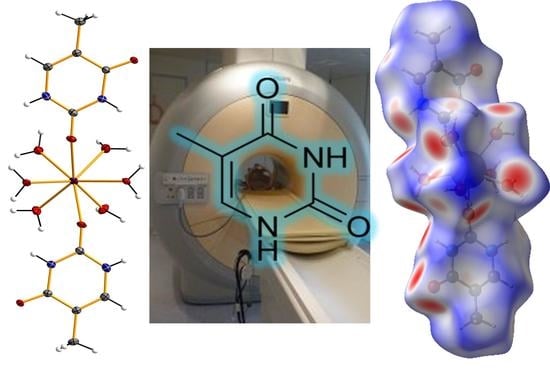A Gadolinium(III) Complex Based on the Thymine Nucleobase with Properties Suitable for Magnetic Resonance Imaging
Abstract
1. Introduction
2. Results and Discussion
2.1. Synthetic Procedure
2.2. IR Spectroscopy
2.3. Description of the Crystal Structure
2.4. Analysis of the Hirshfeld Surfaces
2.5. Magnetic Properties
2.6. MR Imaging Phantom Studies
3. Materials and Methods
3.1. Reagents and Instruments
3.2. Preparation of Compound
3.3. X-ray Data Collection and Structure Refinement
4. Conclusions
Supplementary Materials
Author Contributions
Funding
Institutional Review Board Statement
Informed Consent Statement
Data Availability Statement
Acknowledgments
Conflicts of Interest
References
- Lippert, B.; Sanz Miguel, P.J. The renaissance of metal–pyrimidine nucleobase coordination chemistry. Acc. Chem. Res. 2016, 49, 1537–1545. [Google Scholar] [CrossRef] [PubMed]
- Somerville, R.L. Encyclopedia of Genetics; Academic Press: San Diego, CA, USA, 2001; pp. 1965–1966. [Google Scholar]
- Park, H.J.; Zhang, K.; Ren, Y.; Nadji, S.; Sinha, N.; Taylor, J.-S.; Kang, C.H. Crystal structure of a DNA decamer containing a cis-syn thymine dimer. Proc. Natl. Acad. Sci. USA 2002, 99, 15965–15970. [Google Scholar] [CrossRef]
- Sakate, M.; Hosoda, H.; Suzuki, T. Crystal structures of bis–[2-(pyridin-2-yl)phenyl-κ2N,C1]rhodium(III) complexes containing an acetonitrile or monodentate thyminate(1−) ligand. Acta Cryst. 2016, E72, 543–547. [Google Scholar] [CrossRef] [PubMed]
- Vegas, V.G.; Lorca, R.; Latorre, A.; Hassanein, K.; Gómez-García, C.J.; Castillo, O.; Somoza, A.; Zamora, F.; Amo-Ochoa, P. Copper(II)-thymine coordination polymer nanoribbons as potential oligonucleotide nanocarriers. Angew. Chem. Int. Ed. 2017, 56, 987–991. [Google Scholar] [CrossRef] [PubMed]
- Correa, R.S.; Freire, V.; Barbosa, M.I.F.; Bezerra, D.P.; Bomfim, L.M.; Moreira, D.R.M.; Soares, M.B.P.; Ellena, J.; Batista, A.A. Ru(II)–thyminate complexes: New metallodrug candidates against tumor cells. New J. Chem. 2018, 42, 6794–6802. [Google Scholar] [CrossRef]
- Silva, S.L.R.; Baliza, I.R.S.; Dias, R.B.; Sales, C.B.S.; Rocha, C.A.G.; Soares, M.B.P.; Correa, R.S.; Batista, A.A.; Bezerra, D.P. Ru(II)-thymine complex causes DNA damage and apoptotic cell death in human colon carcinoma HCT116 cells mediated by JNK/p38/ERK1/2 via a p53-independent signaling. Sci. Rep. 2019, 9, 11094. [Google Scholar] [CrossRef]
- De, H.; Paul, A.; Datta, A. Theoretical study of Au4 thymine, Au20 and Ag20 uracil and thymine complexes for surface enhanced Raman scattering. Comput. Theor. Chem. 2017, 1111, 1–13. [Google Scholar] [CrossRef]
- Kondo, J.; Yamada, T.; Hirose, C.; Okamoto, I.; Tanaka, Y.; Ono, A. Crystal structure of metallo DNA duplex containing consecutive Watson-Crick-like T-Hg(II)-T base pairs. Angew. Chem. Int. Ed. 2014, 24, 2385–2388. [Google Scholar] [CrossRef]
- Yamaguchi, H.; Šebera, J.; Kondo, J.; Oda, S.; Komuro, T.; Kawamura, T.; Dairaku, T.; Kondo, Y.; Okamoto, I.; Ono, A.; et al. The structure of metallo-DNA with consecutive thymine–HgII–thymine base pairs explains positive entropy for the metallo base pair formation. Nucleic Acids Res. 2014, 42, 4094–4099. [Google Scholar] [CrossRef]
- Kuriyama, M.; Haruta, K.; Dairaku, T.; Kawamura, T.; Kikkawa, S.; Inamoto, K.; Tsukamoto, H.; Kondo, Y.; Torigoe, H.; Okamoto, I.; et al. Hg2+-trapping beads: Hg2+-specific recognition through thymine–Hg(II)–thymine base pairing. Chem. Pharm. Bull. 2014, 62, 709–712. [Google Scholar] [CrossRef]
- Li, L.; Wen, Y.; Xu, L.; Xu, Q.; Song, S.; Zuo, X.; Yan, J.; Zhang, W.; Liu, G. Development of mercury (II) ion biosensors based on mercury-specific oligonucleotide probes. Biosens. Bioelectron. 2016, 75, 433–445. [Google Scholar] [CrossRef] [PubMed]
- Chun, H.J.; Kim, S.; Han, Y.D.; Kim, D.W.; Kim, K.R.; Kim, H.S.; Kim, J.H.; Yoon, H.C. Water-soluble mercury ion sensing based on the thymine-Hg2+-thymine base pair using retroreflective Janus particle as an optical signaling probe. Biosens. Bioelectron. 2018, 104, 138–144. [Google Scholar] [CrossRef] [PubMed]
- Kashima, A.; Sakate, M.; Ota, H.; Fuyuhiro, A.; Sunatsukia, Y.; Suzuki, T. Thyminate(2−)-bridged cyclic tetranuclear rhodium(III) complexes formed by a template of a sodium, calcium or lanthanoid ion. Chem. Commun. 2015, 51, 1889–1892. [Google Scholar] [CrossRef] [PubMed]
- Armentano, D.; Marino, N.; Mastropietro, T.F.; Martínez-Lillo, J.; Cano, J.; Julve, M.; Lloret, F.; De Munno, G. Self-assembly of a chiral carbonate- and cytidine-containing dodecanuclear Copper(II) Complex: A multiarm-supplied globular capsule. Inorg. Chem. 2008, 47, 10229–10231. [Google Scholar] [CrossRef] [PubMed]
- Martínez-Lillo, J.; Mastropietro, T.F.; Lappano, R.; Madeo, A.; Alberto, M.E.; Russo, N.; Maggiolini, M.; De Munno, G. Rhenium(IV) compounds inducing apoptosis in cancer cells. Chem. Commun. 2011, 47, 5283–5285. [Google Scholar] [CrossRef]
- Marino, N.; Armentano, D.; Mastropietro, T.F.; Julve, M.; De Munno, G.; Martínez-Lillo, J. Cubane-Type CuII4 and MnII2MnIII2 complexes based on pyridoxine: A versatile ligand for metal assembling. Inorg. Chem. 2013, 52, 11934–11943. [Google Scholar] [CrossRef]
- Armentano, D.; Barquero, M.A.; Rojas-Dotti, C.; Moliner, N.; De Munno, G.; Brechin, E.K.; Martínez-Lillo, J. Enhancement of intermolecular magnetic exchange through halogen···halogen interactions in bisadeninium rhenium(IV) salts. Cryst. Growth Des. 2017, 17, 5342–5348. [Google Scholar] [CrossRef]
- Orts-Arroyo, M.; Castro, I.; Lloret, F.; Martínez-Lillo, J. Field-induced slow relaxation of magnetisation in two one-dimensional homometallic dysprosium(III) complexes based on alpha- and beta-amino acids. Dalton Trans. 2020, 49, 9155–9163. [Google Scholar] [CrossRef]
- Orts-Arroyo, M.; Castro, I.; Martínez-Lillo, J. Detection of Hypoxanthine from inosine and unusual hydrolysis of immunosuppressive drug azathioprine through the formation of a diruthenium(III) system. Biosensors 2021, 11, 19. [Google Scholar] [CrossRef] [PubMed]
- Colarusso, P.; Zhang, K.-Q.; Guo, B.; Bernath, P.F. The infrared spectra of uracil, thymine, and adenine in the gas phase. Chem. Phys. Lett. 1997, 269, 39–48. [Google Scholar] [CrossRef]
- Singh, J.S. FTIR and Raman spectra and fundamental frequencies of biomolecule: 5-Methyluracil (thymine). J. Mol. Struct. 2008, 876, 127–133. [Google Scholar] [CrossRef]
- Azab, H.A.; Al-Deyab, S.S.; Anwar, Z.M.; El-Gawad, I.I.A.; Kamel, R.M. Comparison of the coordination tendency of amino acids, nucleobases, or mononucleotides toward the monomeric and dimeric lanthanide complexes with biologically important compounds. J. Chem. Eng. Data 2011, 56, 2613–2625. [Google Scholar] [CrossRef]
- Guillou, O.; Bergerat, P.; Kahn, O.; Bakalbassis, E.; Boubekeur, K.; Batail, P.; Guillot, M. Ferromagnetically coupled gadolinium(III)copper(II) molecular material. Inorg. Chem. 1992, 31, 110–114. [Google Scholar] [CrossRef]
- Cañadillas-Delgado, L.; Fabelo, O.; Cano, J.; Ruiz-Pérez, C. Magnetic Interactions in Oxo-Carboxylate Bridged Gadolinium(III) Complexes Synthesis, Crystal Structures and Magnetic Properties; Nova Science Publishers, Inc.: Hauppauge, NY, USA, 2010. [Google Scholar]
- Martínez-Lillo, J.; Cañadillas-Delgado, L.; Cano, J.; Lloret, F.; Julve, M.; Faus, J. A heteropentanuclear oxalato-bridged [ReIV4GdIII] complex: Synthesis, crystal structure and magnetic properties. Chem. Commun. 2012, 48, 9242–9244. [Google Scholar] [CrossRef] [PubMed]
- Portalone, G.; Bencivenni, L.; Colapietro, M.; Pieretti, A.; Ramondo, F. The Effect of hydrogen bonding on the structures of uracil and some methyl derivatives studied by experiment and theory. Acta Chem. Scand. 1999, 53, 57–68. [Google Scholar] [CrossRef][Green Version]
- Llunell, M.; Casanova, D.; Cirera, J.; Alemany, P.; Alvarez, S. SHAPE 2.1; Universitat de Barcelona: Barcelona, Spain, 2013. [Google Scholar]
- Spackman, M.A.; Jayatilaka, D. Hirshfeld surface analysis. CrystEngComm 2009, 11, 19–32. [Google Scholar] [CrossRef]
- Turner, M.J.; McKinnon, J.J.; Wolff, S.K.; Grimwood, D.J.; Spackman, P.R.; Jayatilaka, D.; Spackman, M.A. Crystal Explorer 17; University of Western Australia: Perth, Australia, 2017. [Google Scholar]
- Orts-Arroyo, M.; Castro, I.; Lloret, F.; Martínez-Lillo, J. Molecular self-assembly in a family of oxo-bridged dinuclear ruthenium(IV) systems. Cryst. Growth Des. 2020, 20, 2044–2056. [Google Scholar] [CrossRef]
- Kahn, O. Molecular Magnetism; VCH: New York, NY, USA, 1993. [Google Scholar]
- Mousavi, B.; Chauvin, A.-S.; Moriggi, L.; Helm, L. Carbazole as linker for dinuclear gadolinium-based MRI contrast agents. Eur. J. Inorg. Chem. 2017, 5403–5412. [Google Scholar] [CrossRef]
- Rohrer, M.; Bauer, H.; Mintorovitch, J.; Requardt, M.; Weinmann, H.-J. Comparison of magnetic properties of MRI contrast media solutions at different magnetic field strengths. Investig. Radiol. 2005, 40, 715–724. [Google Scholar] [CrossRef] [PubMed]
- Bruker Analytical X-ray Instruments. SHELXL-2018/1; Bruker Analytical X-ray Instruments: Madison, WI, USA, 2018. [Google Scholar]
- Crystal Impact GbR. DIAMOND 4.5.0; Crystal Impact GbR: Bonn, Germany, 2018. [Google Scholar]


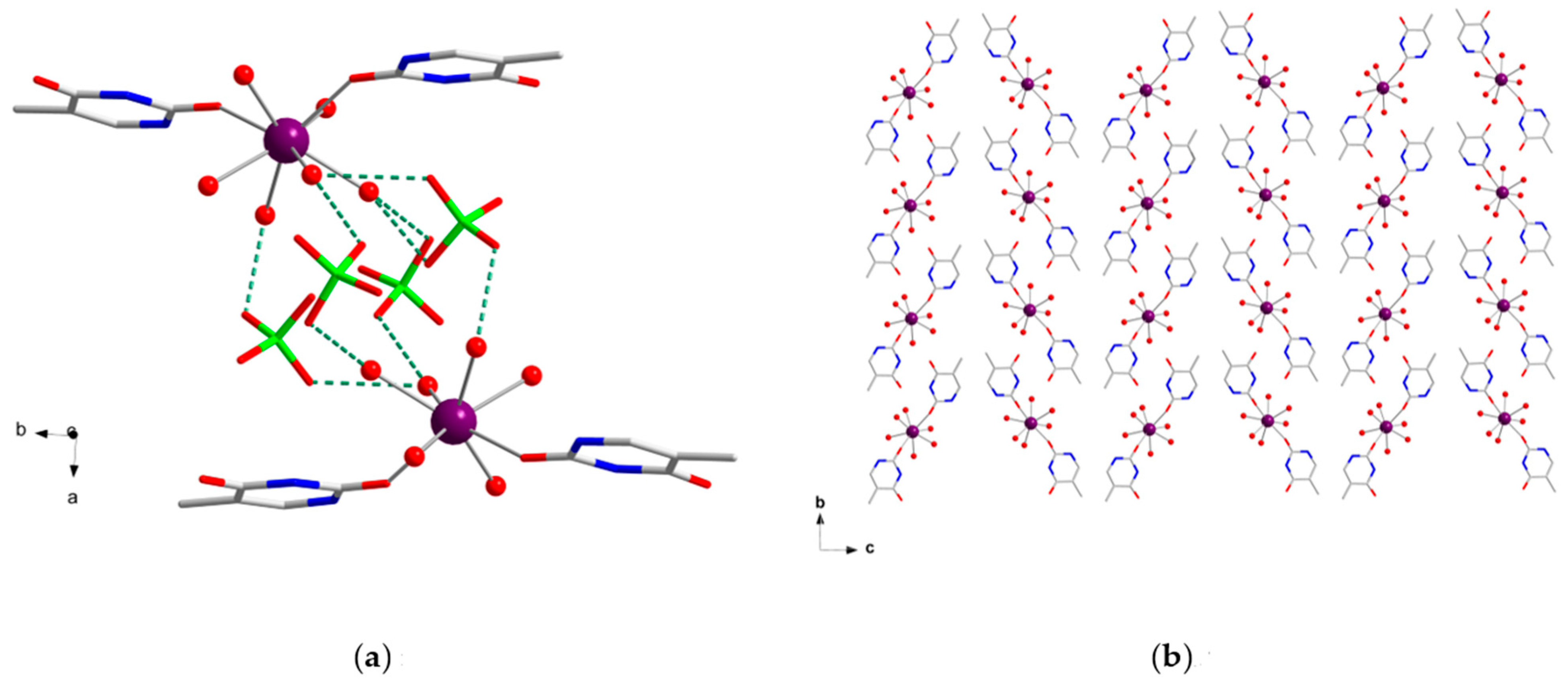
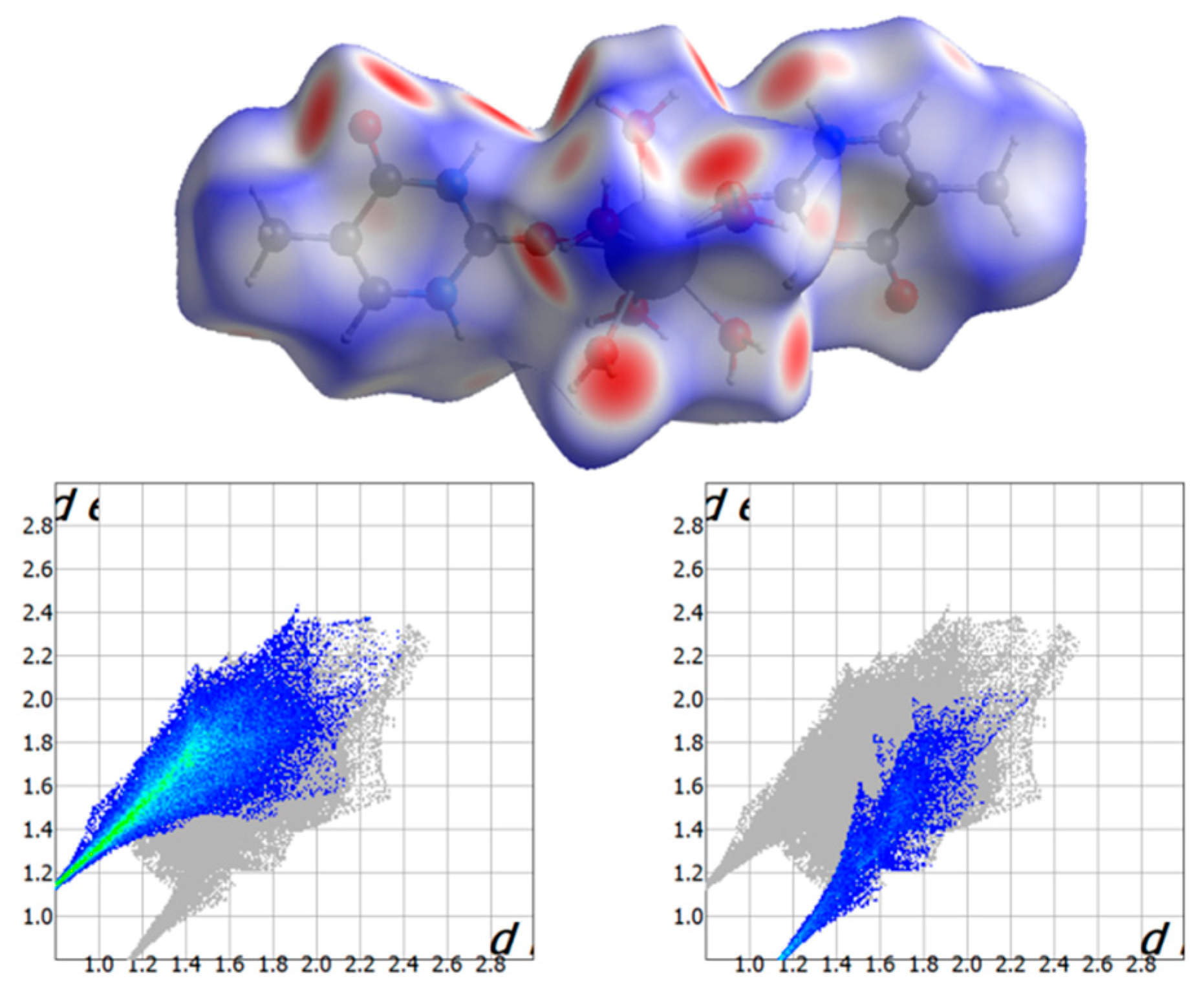
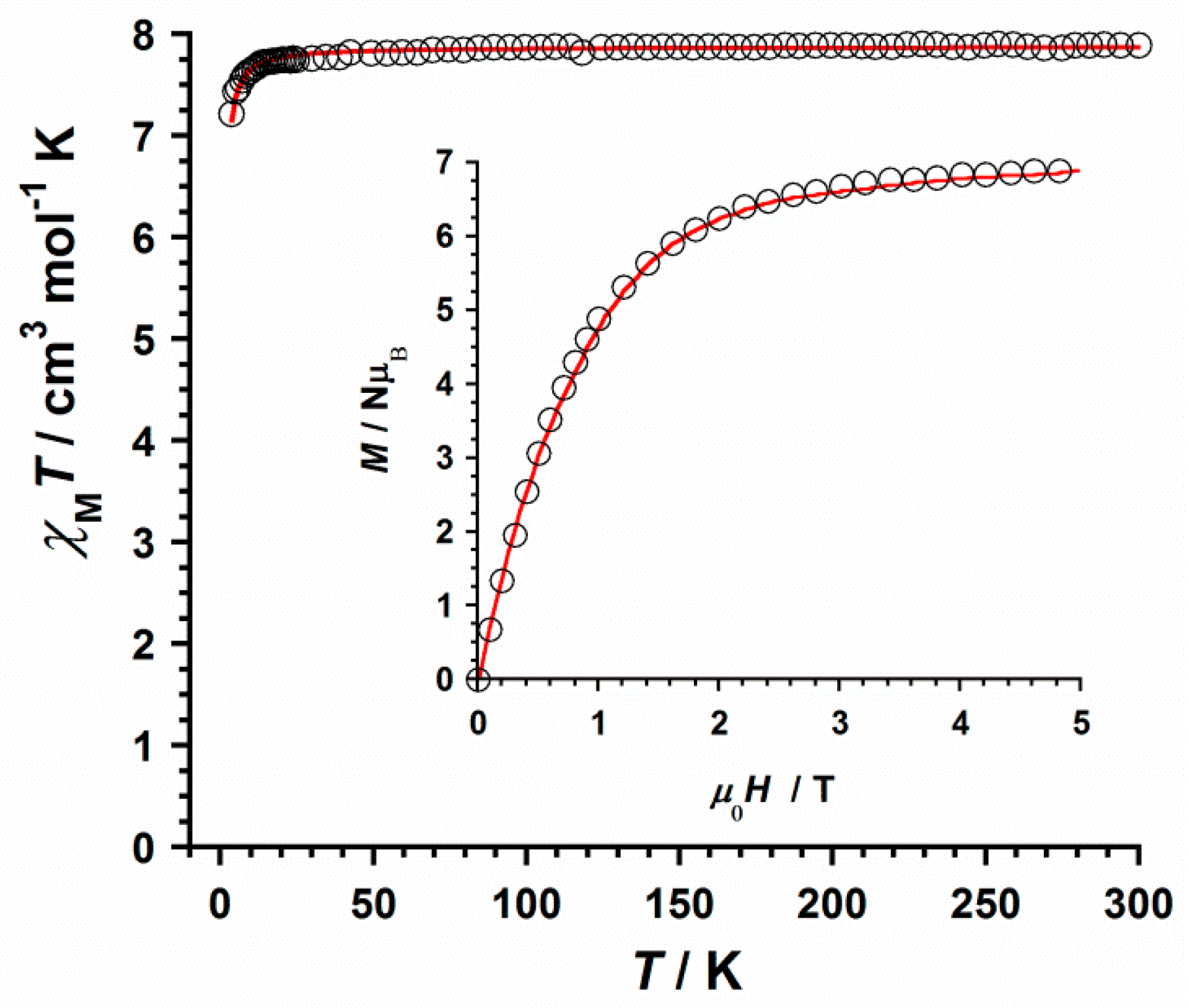
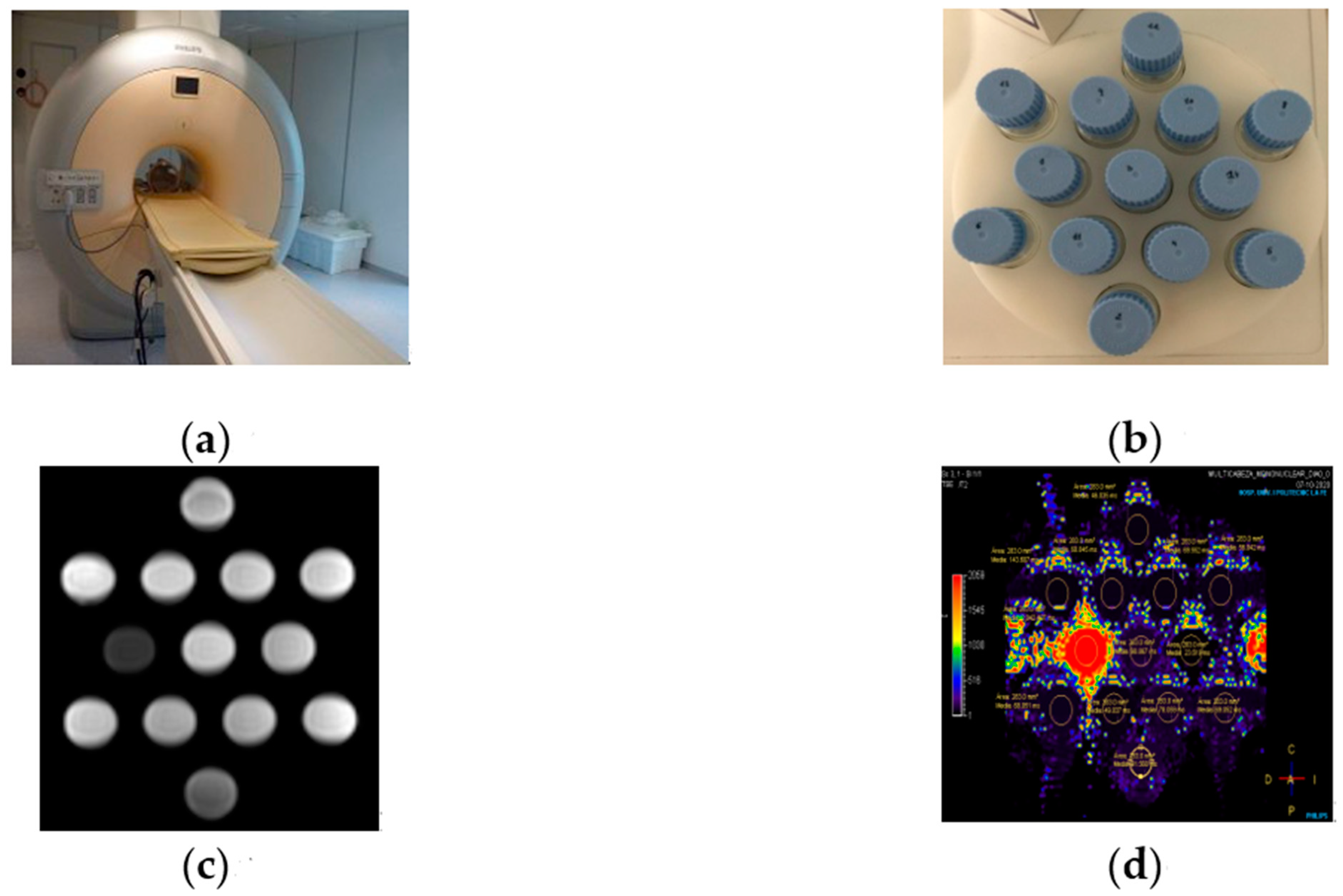
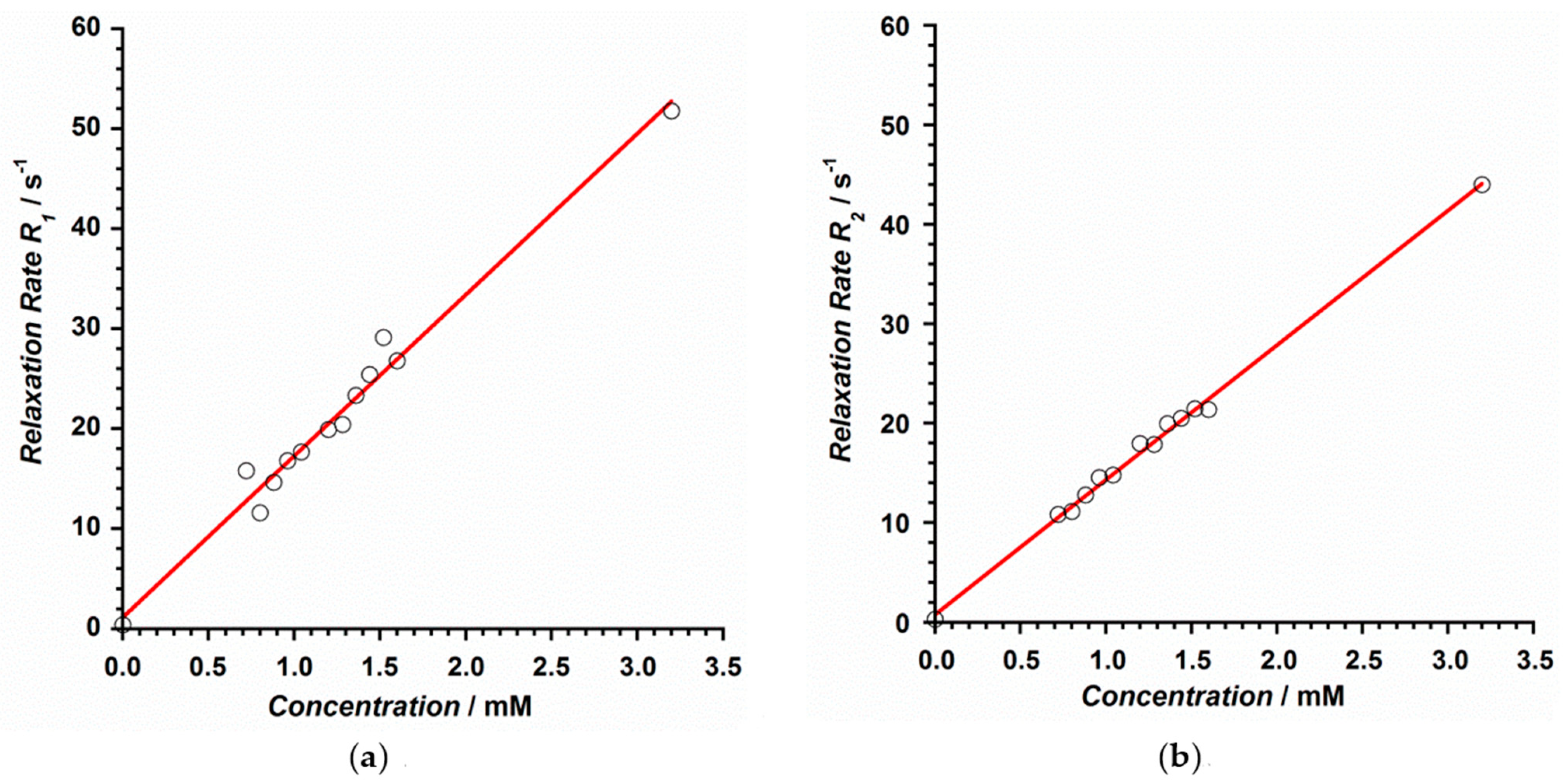
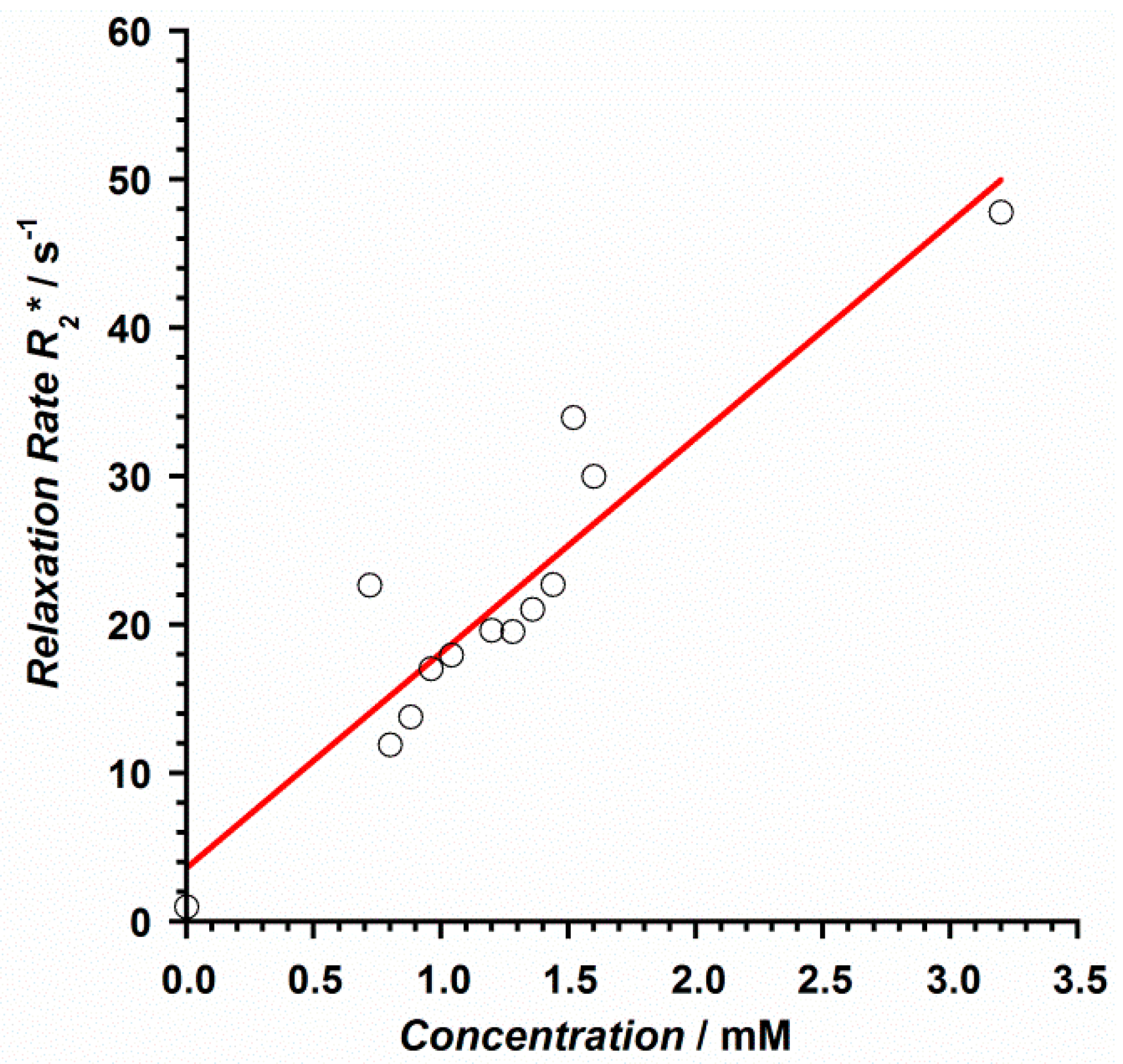
| Compound | 1 |
|---|---|
| CCDC | 2009091 |
| Formula | C10H28N4O24Cl3Gd |
| Mr/g mol−1 | 851.96 |
| Crystal system | Monoclinic |
| Space group | P21/c |
| a/Å | 13.192 (1) |
| b/Å | 9.901 (1) |
| c/Å | 20.985 (1) |
| α/° | 90 |
| β/° | 95.18 (1) |
| γ/° | 90 |
| V/Å3 | 2729.8 (2) |
| Z | 4 |
| Dc/g cm−3 | 2.073 |
| μ (Mo − Kα)/mm−1 | 2.832 |
| Goodness-of-fit on F2 | 1.081 |
| R1 [I > 2σ (I)]/all | 0.0280/0.0325 |
| wR2 [I > 2σ (I)]/all | 0.0703/0.0733 |
| D-H·A | D-H/Å | H·A/Å | D·A/Å | (DHA)/° |
|---|---|---|---|---|
| N(1)-H(1)···O(8f) | 0.880 | 2.12(1) | 2.982(1) | 165.4(1) |
| N(3)-H(3)···O(4a) | 0.880 | 1.89(1) | 2.763(1) | 175.6(1) |
| N(10)-H(10)···O(2g) | 0.880 | 1.92(1) | 2.785(1) | 168.7(1) |
| O(1w)-H(1wA)···O(7) | 0.951 | 2.05(1) | 2.986(1) | 168.4(1) |
| O(1w)-H(1wB)···O(4a) | 0.953 | 1.77(1) | 2.677(1) | 159.1(1) |
| O(2w)-H(2wA)···O(2g) | 0.948 | 1.75(1) | 2.691(1) | 169.2(1) |
| O(3w)-H(3wA)···O(11b) | 0.953 | 2.07(1) | 2.944(1) | 151.0(1) |
| O(3w)-H(3wB)···O(7wf) | 0.950 | 1.76(1) | 2.660(1) | 156.0(1) |
| O(4w)-H(4wA)···O(10b) | 0.951 | 2.01(1) | 2.870(1) | 149.4(1) |
| O(4w)-H(4wB)···O(15c) | 0.953 | 1.944(1) | 2.847(1) | 157.4(1) |
| O(5w)-H(5wA)···O(12) | 0.950 | 1.77(1) | 2.713(1) | 169.2(1) |
| O(5w)-H(5wB)···O(14) | 0.950 | 1.87(1) | 2.810(1) | 169.1(1) |
| O(6w)-H(6wA)···O(9h) | 0.951 | 2.27(1) | 2.939(1) | 126.9(1) |
| O(6w)-H(6wA)···O(7wf) | 0.951 | 2.31(1) | 2.986(1) | 127.4(1) |
| O(6w)-H(6wB)···O(8w) | 0.953 | 1.75(1) | 2.694(1) | 171.9(1) |
| O(7w)-H(7wB)···O(8wc) | 0.961 | 1.91(1) | 2.896(1) | 172.5(1) |
| O(8w)-H(8wA)···O(13) | 0.954 | 1.91(1) | 2.855(1) | 170.8(1) |
| O(8w)-H(8wB)···O(15e) | 0.953 | 1.92(1) | 2.846(1) | 163.9(1) |
| HPY | HBPY | CU | SAPR | TDD | JGBF | JETBPY | BTPR | JSD | TT |
|---|---|---|---|---|---|---|---|---|---|
| 23.392 | 16.322 | 9.171 | 0.307 | 1.913 | 15.656 | 28.471 | 1.733 | 4.830 | 10.015 |
Publisher’s Note: MDPI stays neutral with regard to jurisdictional claims in published maps and institutional affiliations. |
© 2021 by the authors. Licensee MDPI, Basel, Switzerland. This article is an open access article distributed under the terms and conditions of the Creative Commons Attribution (CC BY) license (https://creativecommons.org/licenses/by/4.0/).
Share and Cite
Orts-Arroyo, M.; Ten-Esteve, A.; Ginés-Cárdenas, S.; Castro, I.; Martí-Bonmatí, L.; Martínez-Lillo, J. A Gadolinium(III) Complex Based on the Thymine Nucleobase with Properties Suitable for Magnetic Resonance Imaging. Int. J. Mol. Sci. 2021, 22, 4586. https://doi.org/10.3390/ijms22094586
Orts-Arroyo M, Ten-Esteve A, Ginés-Cárdenas S, Castro I, Martí-Bonmatí L, Martínez-Lillo J. A Gadolinium(III) Complex Based on the Thymine Nucleobase with Properties Suitable for Magnetic Resonance Imaging. International Journal of Molecular Sciences. 2021; 22(9):4586. https://doi.org/10.3390/ijms22094586
Chicago/Turabian StyleOrts-Arroyo, Marta, Amadeo Ten-Esteve, Sonia Ginés-Cárdenas, Isabel Castro, Luis Martí-Bonmatí, and José Martínez-Lillo. 2021. "A Gadolinium(III) Complex Based on the Thymine Nucleobase with Properties Suitable for Magnetic Resonance Imaging" International Journal of Molecular Sciences 22, no. 9: 4586. https://doi.org/10.3390/ijms22094586
APA StyleOrts-Arroyo, M., Ten-Esteve, A., Ginés-Cárdenas, S., Castro, I., Martí-Bonmatí, L., & Martínez-Lillo, J. (2021). A Gadolinium(III) Complex Based on the Thymine Nucleobase with Properties Suitable for Magnetic Resonance Imaging. International Journal of Molecular Sciences, 22(9), 4586. https://doi.org/10.3390/ijms22094586







